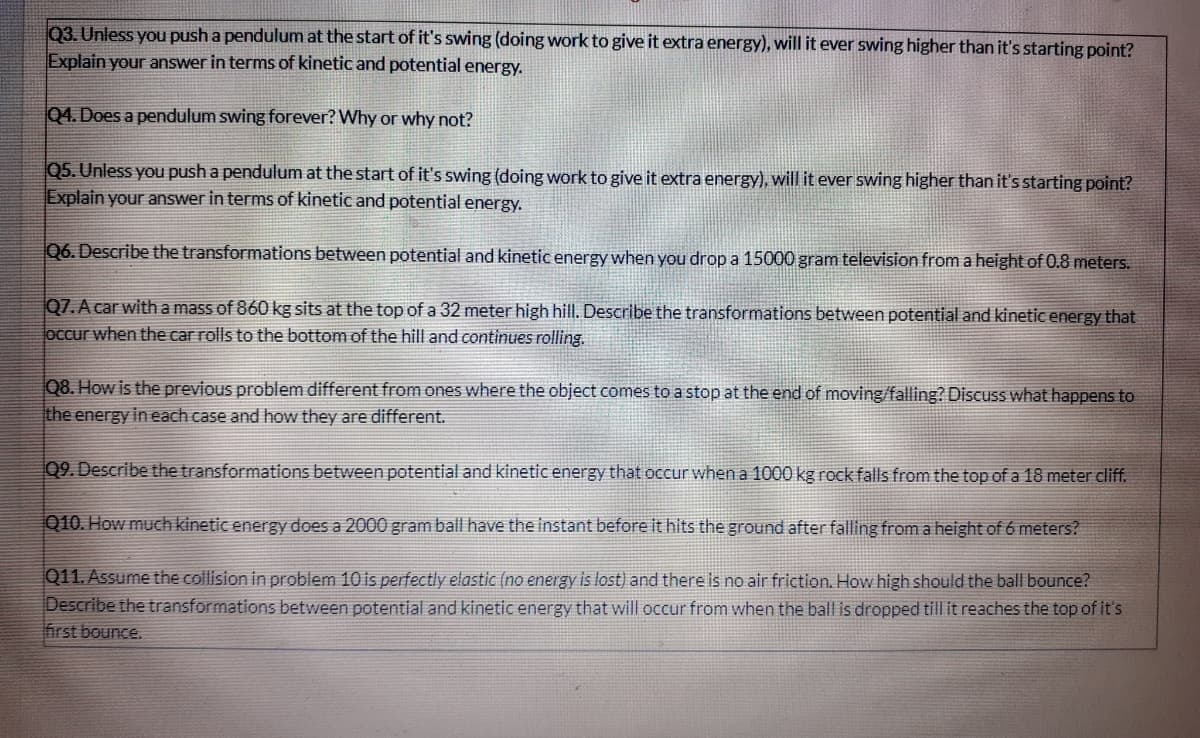Q1. Explain the conservation of energy in terms of the energy transformation(s) that occur when you strike (light) a match. Q2. When you turn on a lamp at home you are using electricity generated by a power company or public utility. Assume the electricity powering the lamp was generated at a coal burning power plant and explain the conservation of energy in terms of the energy transformations that occur when you turn on the lamp.
Q1. Explain the conservation of energy in terms of the energy transformation(s) that occur when you strike (light) a match. Q2. When you turn on a lamp at home you are using electricity generated by a power company or public utility. Assume the electricity powering the lamp was generated at a coal burning power plant and explain the conservation of energy in terms of the energy transformations that occur when you turn on the lamp.
Glencoe Physics: Principles and Problems, Student Edition
1st Edition
ISBN:9780078807213
Author:Paul W. Zitzewitz
Publisher:Paul W. Zitzewitz
Chapter17: Reflections And Mirrors
Section: Chapter Questions
Problem 101A
Related questions
Question

Transcribed Image Text:Q1. Explain the conservation of energy in terms of the energy transformation(s) that occur when you strike (light) a match.
Q2. When you turn on a lamp at home you are using electricity generated by a power company or public utility. Assume the electricity powering
the lamp was generated at a coal burning power plant and explain the conservation of energy in terms of the energy transformations that occur
when you turn on the lamp.

Transcribed Image Text:Q3. Unless you push a pendulum at the start of it's swing (doing work to give it extra energy), will it ever swing higher than it's starting point?
Explain your answer in terms of kinetic and potential energy.
Q4. Does a pendulum swing forever? Why or why not?
Q5. Unless you push a pendulum at the start of it's swing (doing work to give it extra energy), will it ever swing higher than it's starting point?
Explain your answer in terms of kinetic and potential energy.
Q6. Describe the transformations between potential and kinetic energy when you drop a 15000 gram television from a height of 0.8 meters.
Q7. A car with a mass of 860 kg sits at the top of a 32 meter high hill. Describe the transformations between potential and kinetic energy that
occur when the car rolls to the bottom of the hill and continues rolling.
Q8. How is the previous problem different from ones where the object comes to a stop at the end of moving/falling? Discuss what happens to
the energy in each case and how they are different.
09. Describe the transformations between potential and kinetic energy that occur when a 1000 kg rock falls from the top of a 18 meter cliff.
Q10. How much kinetic energy does a 2000 gram ball have the instant before it hits the ground after falling from a height of 6 meters?
Q11. Assume the collision in problem 10 is perfectly elastic (no energy is lost) and there is no air friction. How high should the ball bounce?
Describe the transformations between potential and kinetic energy that will occur from when the ball is dropped till it reaches the top of it's
first bounce.
Expert Solution
This question has been solved!
Explore an expertly crafted, step-by-step solution for a thorough understanding of key concepts.
This is a popular solution!
Trending now
This is a popular solution!
Step by step
Solved in 2 steps

Knowledge Booster
Learn more about
Need a deep-dive on the concept behind this application? Look no further. Learn more about this topic, physics and related others by exploring similar questions and additional content below.Recommended textbooks for you

Glencoe Physics: Principles and Problems, Student…
Physics
ISBN:
9780078807213
Author:
Paul W. Zitzewitz
Publisher:
Glencoe/McGraw-Hill


College Physics
Physics
ISBN:
9781938168000
Author:
Paul Peter Urone, Roger Hinrichs
Publisher:
OpenStax College

Glencoe Physics: Principles and Problems, Student…
Physics
ISBN:
9780078807213
Author:
Paul W. Zitzewitz
Publisher:
Glencoe/McGraw-Hill


College Physics
Physics
ISBN:
9781938168000
Author:
Paul Peter Urone, Roger Hinrichs
Publisher:
OpenStax College

Physics for Scientists and Engineers, Technology …
Physics
ISBN:
9781305116399
Author:
Raymond A. Serway, John W. Jewett
Publisher:
Cengage Learning